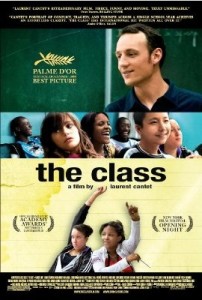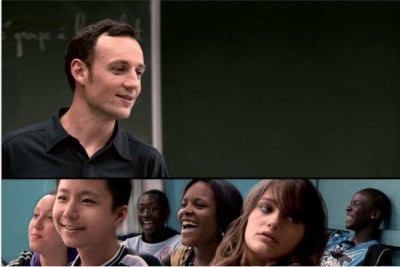By: debbie lynn elias

It seems only fitting now that Academy Award nominations have been announced that I start off my month of Oscar coverage with a review of the Oscar nominee for Best Foreign Language Film, and my pick for Oscar gold, France’s entry, the powerful and wonderfully expressive and captivating, THE CLASS (Entre Les Murs). Already winner of the 2008 Palme d’Or in Cannes, THE CLASS is based on the novel by Francois Begaudeau, who also stars in the film, and also writes the screenplay together with director Laurent Cantet and Robin Campillo, achieving perfect union of documentary and drama.
Francois Marin is a dedicated high school teacher in one of the toughest and most diverse neighborhoods in suburban Paris. Black, White, Arab, rich, poor. There is someone from every demographic. African immigrants go toe-to-toe with the Hispanics in their own form of gang rivalry. Arthur, a long Goth male is striking and dynamic while the little Asian girls are shy and quiet, appearing ever studious. And what about Wei, a very shy young Chinese immigrant, wants to be perfect and goes out of his way to be outgoing and “helpful” but is embarrassed because his French is not perfect. Of particular note are several students – Esmerelda aka “Sandra”, the loud-mouthed ill-mannered, brassy African American girl who, going against type, is reading Plato’s “Republic”, a non-assignment; Khoumba whose own personal drama and trauma causes a 180 degree spin in her academics; and Souleymane, an immigrant from Mali, is the resident troublemaker, who despite his combative and argumentative ways, shows great potential which it seems only Francois can see.
As with any new school year, Francois and his fellow teachers anxiously look forward to the new crop of students as well as those returning, wanting to provide the best education possible to these young people. Despite frustration and problems in the past, the faculty is optimistic and enthusiastic, desiring to challenge and educate not only their students, but themselves. Concentrating primarily on two dozen students in a language class where proper French vocabulary and grammar is the focus of attention (yes kids, even in France students are taught, or forced to endure, grammar), we are privy to this microcosmic intimate portrait and anthropological study of teachers and students. What makes this film so compelling though, is the interaction between the students and their teacher, Francois. But the biggest surprise comes from the fact that the “students” in the film are not Francois’ students, but are, in fact, students from Francoise Dolto Junior High in the 20th arrondissement, all of whom were ultimately cast for this film after taking part in acting workshops held by Cantet. It is their “acting” and ability to bring realism to their scripted roles that bring it all home, making THE CLASS the success that it is.
In crafting the script, it was always Cantet’s intention to make Souleymane a focal point of the story. “I wrote first script before reading the book by Francois. Souleymane was the main character from the old film. I wanted his story to become the plot line of the film. What Francois’ book gave to me, to the film, was all what was around the story and what makes it look real.”
A standout is the development of one teacher who is rather democratic rather than dictatorial but who has his own moments of fallacy, particularly when referring to some of the students as “acting like skanks.” According to Cantet, “It’s someone who takes a risk to be democratic which is not easy when you are in front of 25 people. It was important for me not to create a character that would be too perfect. This guy is just human. He is in front of 25 humans who are trying to trick him and he is just always answering in improvisation. Of course, when you are doing this you are taking the risk to makes mistakes and these mistakes make him more human. I don’t like heroic characters. This shows that even when you try to make your best, you can make mistakes and when you are working with human beings like a teacher does, it can have great consequences.”
Talking with Cantet about his process for this film, a former teacher himself, it is clear from the start that this is a topic very personal to him. “In France we have a very old debate on schools. The debate is always very ideological. I wanted to try to show what really can happen in a class like that. Just look at what’s happening and then people can think about that then make their own mind on that. The other point was that I think looking at these little microcosms you can describe all the issues where society is now facing without really looking at the issues. We sometimes try to avoid to look at the real issues because it’s easier to have preconceived ideas on things.”
A collaborative effort between Cantet and the students/actors, “when I’m working with non-provisional actors, I am waiting for [contributions and input] from them. To make them really bring to the film their own experience of life. School is something when you are not a teacher or student, you don’t know exactly what’s happening inside. It was intriguing for me to listen to what they had to say about their lives. They didn’t write the film with me, but we really take into account what they proposed in the writing of the script. We organized work shops with them in schools and we always tested the situation we were writing, the day after with them.” Surprising even to Cantet was “ the involvement of the students with the work we did together. It was very interesting to see how much they were happy to speak of themselves, to show their own life, and how concentrated they could be on the work we were doing. The teachers who are real teachers in the school were so impressed by that and so jealous seeing that we could focus them for the whole day on one scene.” This is not your typical teacher-student genre film. There is a power that emanates from the screen and the performances that is empowering to the audience and is applicable to life outside the classroom.
Given full creative freedom in both his content and from a technical standpoint, Cantet filmed in HD and widescreen, wanting “to be able to respect the energy of each scene. I needed to be able to shoot very long shots just to respect the real theme that was happening in front of the camera. The only way to get to that was to shoot in HD rather than 35mm. But at the same time I didn’t want the film to look like a documentary film. That’s also the reason why we decided to film in widescreen. It lends more to fiction than to documentary film. We really wanted to show the difference between documentary film and this one.” Technically impressive, Cantet used a three camera format – almost unheard of in a film of this nature. “One on the teacher; one on the student who was speaking at the moment and one preparing itself for the next shot or trying to catch the image of what can happen in a classroom – someone dreaming, someone sleeping – all those little differences that really make the class exist.” Equally incredible is that the cameras were seamless as if melting into the walls, not interrupting the ebb and flow of the classroom situation at hand.
Particularly notable and something that sets the tone of the entire film is the opening sequence, in essence, the first day of school. The students are told to get a piece of paper, put their name on a piece of paper with block letters. But, as the camera is moving from student to student, you see there is not block lettering there. You have some have drawn pictures. Some have doodles. Some have curly-ques. The flow was so natural. So realistic. Yet, when I asked Cantet about it, even I was surprised to learn that the entire scene was scripted. This shows not only how well Cantet can execute a vision and concept, but the talent of these young people as actors.
So real and affecting is this story, the characters and the film, that one can’t help but be rapt with attention, soaking up every word, every action, every reaction, just as if you, yourself, were sitting in a classroom with your favorite teacher, not wanting to miss even one scintilla of the educational experience of school and life. This may be a French film, but it speaks a universal language. According to Cantet, “what the film tries to show is that diversity is not a problem like a people want to say, but it can be a richness. Children are much more open to everything because they are confronted with situations very much different from their own life. They are discussing with children who have different cultures, different ways of thinking and to be together like that is very important.”
Laurent Cantet – go straight to the head of the class and on to Oscar gold with THE CLASS.
Francois Marin – Francois Begaudeau Souleymane – Franck Keita Arthur – Arthur Fogel Wei – Wey Huang Esmerelda – Esmerelda Ouertani
Directed by Laurent Cantet. Written by Francois Begaudeau, Cantet and Robin Campillo.











